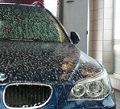Quicksilver77 ma na automacie moc katalogową, ale to nie znaczy że pomiar u Ciebie też jest dla KM i Nm tak samo poprawny. A może przez dolot Quick ma więcej, i Tobie też powinno wyjść więcej niż po dodaniu 30%?
Wkleję coś, przepraszam że po angielsku ale nie chce mi się tłumaczyć...
W skrócie powiem, że dotyczy właśnie różnic w mocy i momencie na silniku i kołach w Coupe V6. Podejrzewam, że analogicznie (chociaż wartości mogą się różnić) jest dla innych silników.
Przyjmijcie jednak, że ja mam V6, a ono ma nieco inną charakterystykę niż L4.
Wheel horsepower vs crank horsepower and dynoing your Accord V6.
============================================
Notes about Dynoing in general
The J30A1 engine's SAE net rated power ratings are 200HP @ 5500rpm and 195 lb-ft @ 4700rpm. However, a chassis dynamometer that consumers have access to is MUCH different than the crank engine dynos that manufacturers test the engine alone on. Whereas a crank engine dyno measures engine power directly at the crankshaft output, a chassis dyno measures it at the wheels. Between the engine and the contact patch of the tires there are drivetrain components such as the transmission, torque converter, differential, shafts and axles, and the wheel masses. These components are not "lossless" and take some of the engine's energy - the torque converter in particular. The other major difference is that a crank engine dyno is done with the engine at a steady RPM (i.e. a brake dyno). Chassis dynos are usually the passive rolling load type - meaning the engine is at full throttle while accelerating a large circular drum instead of remaining at a steady RPM. In this case, inertial considerations come into play. The engine does not just spin up freely to redline. Some of the power that the engine generates is used to accelerate the engine itself. The same goes for the transmission, differential, and in particular the wheels. Finally, whatever engine power is left after paying for the inertial costs to spin up all of these components and other drivetrain inefficiencies (torque converter) is what makes it to the tire's contact patch. This is what the dyno reports, and this is what actually accelerates you.
Net result: On the industry standard Dynojet 248C chassis dynamometer, a stock J30A1 Accord will typically see about 155 whp (wheel horsepower) and 145 wtq (wheel torque) versus the crank ratings of 200hp and 195tq. Automatics on this type of dyno will generally see a "loss" of about 22-23% and this is appoximately in line with those numbers. Manual transmissions are usually about 60 pounds lighter than an automatic and also do not have a power sapping torque converter and therefore generally dyno about 5-10% higher than an automatic with the same engine and get much more power to the ground to accelerate you. This is why auto to manual conversions are popular (but difficult) on a lot of cars.
Important Note: You CANNOT directly compare the results from one type of dyno machine to another since the different types read differently. Another popular type of dyno is the Dynapack. This characteristically reads about 6-7% higher than a Dynojet 248C. Therefore, if you are trying to compare Dynapack results to a Dynojet you are comparing apples to oranges. In other words, they are not really comparable. If your friend dynos at 170 whp on a Dynojet and you dyno at 180 whp but on a Dynapack, that does not mean you have 10 whp more than your friend. It simply means that the type of dyno you ran on characteristically reads higher than the Dynojet by about that amount (at these power levels) and that the performance differences between the two cars will be negligible. Even different dynos of the same type can read slightly higher or lower than another. Therefore, when dynoing modifications try to always dyno on the same exact machine to get the most accurate and consistent results.
Notes about dynoing specific to the 6th Generation Accord V6.
Which gear to dyno in.
As it turns out, the 98-02 Accord V6 is actually a pretty difficult car to get a good dyno on. Automatics are always harder to dyno than manuals, and of course all 98-02 AV6s are automatics. To "stage" to get ready to start the dyno, you will need to have the shifter in D3 so that the engine stays in 3rd and then ramp the speed up to about 60 mph. At 60 mph and above, the transmission logic will no longer kick the transmission down to 2nd gear on full throttle even though 2nd will go up to about 73. However, this will only give you a look from 4000 rpm on up. Since it's important to see low/mid-range responsiveness of mods also, the other option is to dyno in "2". This will put the transmission in snow mode. It will not kick-down to 1st gear when full throttle is applied, even from a dead stop. Therefore, you can get a full sweep of the rev-range in 2nd, unlike a 3rd gear dyno.
How to read a dyno chart
DO NOT JUST READ THE PEAK NUMBERS AT THE TOP OF THE CHART BECAUSE ON THIS CAR THEY WILL ALMOST ALWAYS BE WRONG
In addition to that, there is also MUCH more to a dyno than the peak numbers alone. Total area under the curve and curve shape are equally important and modifications can often give drastic changes to the engine's torque curve without actually affecting the peak numbers. LOOK at the graph. All too often people just look at the peak numbers at the top and come to totally wrong conclusions. Below is a stock vs OBX header 3rd gear J30A1 dyno.
The first problem here are the large spikes at the beginning of the dyno. The engine is NOT putting out 175 or even anywhere remotely close to 215 lb-ft of torque to the front wheels. What happened was that instead of staging at about 60 mph in D3, the dyno was done while running up through the gears and started just as the transmission was shifting to 3rd. The large spike is the result of the engine dumping its higher inertial (rotating) energy from redline in 2nd down to a lower RPM in 3rd. This creates a driveline spike and is not "real" power. This automatically throws the peak numbers off at the top and makes them irrelevant.
The second problem is all the way at the right where you see a "hump" in the horsepower and torque curves. In D3 as the engine approaches redline the torque converter will lock. This drops the revs and again causes a smaller but not insignificant "dump" of inertial energy from the engine as it abruptly transitions from higher to lower revs under load. It could also cause calculation errors on the dyno. Again, this is not a real reading of the engine and now the peak numbrers for horsepower listed at the top are once again thrown off and made irrelevant.
The relevant part of the dyno starts at 4400rpm after the 2-3 upshift spikes, and ends at 6100 rpm before the torque converter locks in 3rd gear. However, these two phenomenas are locked in by the peak reading registers of the dyno software and this is what it reports. But those numbers are wrong. You must look at the actual curves and what your engine is doing to get the accurate numbers. In this case the results are as follows.
Stock Horsepower: 158 whp @ 5700rpm (but read 169.1 whp from the torque converter locking)
Stock Torque: 143 wtq @ 4600 rpm (but read 175.9 wtq from the 2-3 upshift spike)
Modded Horsepower: 168 whp @ 5800rpm (but read 177.6 whp from the torque converter locking)
Modded Torque: 154 wtq @ 4600 rpm (but read 215.0 wtq from the 2-3 upshift spike)
REAL GAINS: 10 whp and 11 wtq (According to the peak numbers listed: 8.5 whp and 39.1 wtq )
Other common dyno interpretation mistakes
You cannot directly compare 2nd gear and 3rd gear numbers. First off, the acceleration rate in 2nd gear is higher and this means there will be higher inertial losses (inertial resistance is a function of acceleration) and this could possibly skew your 2nd gear numbers lower. 3rd gear has a lower rate of acceleration and therefore inertial losses will be lower. Because of this, in theory 3rd gear dynos should give slighlty higher numbers although there are many variables. Finally, the torque converter will not lock in 2nd, but it will in 3rd. Since 3rd gear gets the "hump" from the torque converter locking and 2nd does not, this can again throw off interpretation. A certain person who shall remain nameless once did a 2nd gear baseline dyno and then did a post V-AFC tuning dyno in 3rd. They then went around the forum claiming that they gained over 20 whp from tuning when most others only gain 10. However, they incorrectly interpreted the dynos by only reading the peak numbers at the top , and did not take the 10 whp torque converter lock spike out. Accounting for that, they only gained 10 whp which is not any more or less than anybody else. This creates unjustified hype and a lot of misinformation on the forums and is not appreciated by us moderators who try very hard to maintain the quality of information here for the benefit of our members. So please try not to make these mistakes anymore.
Get dynos in SAE corrected form. SAE correction accounts for barometric pressure, temperature, and humidity, all of which can have a significant affect on engine performance. SAE correction therefore allows you to compare your results to others on a much more level playing field.
Pay attention to the scales. On the above dyno one could look easily believe that they are making over 200 whp. However, that is the torque scale, not the horsepower scale. Although it's generally "good practice" to keep the scales between horsepoweer and torque the same, this is not always done. The scale for horsepower is all the way over on the left.






































.png)












